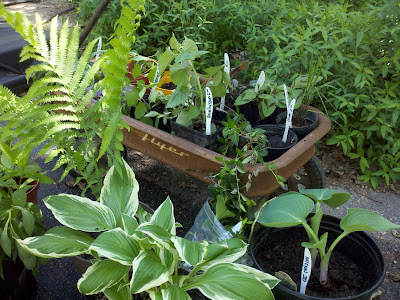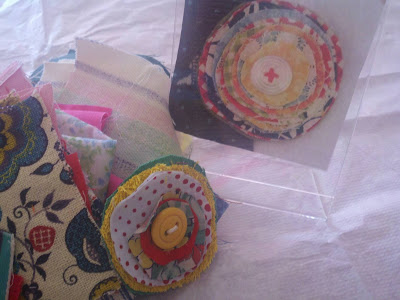Monday, April 30, 2012
MS Track Meet
Cade Ran So Much Last Thursday at the MS Track meet- They did Great! placed in all 4 events. 1st place in the 3200 relay, 3rd in the 1200, 3rd in the 800, and 2nd in the 1600 relay.
Wednesday, April 18, 2012
Rhubarb Berry Slab Pie
Published with Blogger-droid v1.6.5
This was Wonderful!! I love to use Fresh Rhubarb in the Spring! Great Recipe from Taste of Home Magazine- I used a mix of Frozen Blueberries and Raspberries
Ingredients
3-1/4 cups all-purpose flour
1 teaspoon salt
1 cup butter
3/4 cup plus 1 to 2 tablespoons 2% milk
1 egg yolk
2 cups sugar
1/3 cup cornstarch
5 cups fresh or frozen unsweetened raspberries, thawed and drained
3 cups sliced fresh or frozen rhubarb, thawed and drained
VANILLA ICING:
1-1/4 cups confectioners' sugar
1/2 teaspoon vanilla extract
5 to 6 teaspoons 2% milk
Directions
In a large bowl, combine flour and salt; cut in butter until crumbly. Whisk 3/4 cup milk and egg yolk; gradually add to flour mixture, tossing with a fork until dough forms a ball. Add additional milk, 1 tablespoon at a time, if necessary.
Divide dough in half so that one portion is slightly larger than the other; wrap each in plastic wrap. Refrigerate for 1 hour or until easy to handle.
Roll out larger portion of dough between two large sheets of lightly floured waxed paper into an 18-in. x 13-in. rectangle. Transfer to an ungreased 15-in. x 10-in. x 1-in. baking pan. Press onto the bottom and up the sides of pan; trim pastry to edges of pan.
In a large bowl, combine sugar and cornstarch. Add raspberries and rhubarb; toss to coat. Spoon into pastry.
Roll out remaining dough; place over filling. Fold bottom pastry over edge of top pastry; seal with a fork. Prick top with a fork.
Bake at 375° for 45-55 minutes or until golden brown. Cool completely on a wire rack.
For icing, combine confectioners' sugar, vanilla and enough milk to achieve a drizzling consistency; drizzle over pie. Cut pie into squares. Yield: 2 dozen.
Editor's Note: If using frozen rhubarb, measure rhubarb while still frozen, then thaw completely. Drain in a colander, but do not press liquid out.
Monday, April 16, 2012
Monday, April 09, 2012
Friday, April 06, 2012
Wednesday, April 04, 2012
The Hosta Garden Calendar
The Hosta Gardening Calendar
by Bob Solberg,
Spring (Foliage emergence begins): March- April early May
As the ground warms under spring’s ever increasing light intensities, the dormant buds of the hostas begin to swell and break through the mulch, looking like bullets coming out of the ground. The small bud scales that protect the true leaves open and recurve allowing a cigar-shaped flush of usually three to four leaves to emerge well above the ground. Soil temperature and moisture seem to effect the timing of the emergence of hostas the most. In very dry winters the emergence of hostas will be delayed unless the garden is irrigated. As the new hosta leaves expand, ample water is also needed for them to gain maximum size.
Labeling: Check for lost labels and replace as needed.
Light: Full sun, moderate intensity. Usually no shading necessary.
Nutrients: Apply slow release fertilizer (e.g. Osmocote, Nutricote, organic fertilizers) or 10-10- 10 granular fertilizer around clumps as the hostas emerge. If you only use a liquid fertilizer, then apply weekly beginning as the first leaves start to unfurl.
Pests: Begin slug control before hosta leaves emerge. The slugs will be active on warm nights before the hostas will. Try to limit their populations before they hide in the hosta foliage. If early attacks by deer are a problem, spray a repellent. Little is needed at this time but it may need to be repeated every 10 days as the hostas enlarge. Stay on vole patrol.
Protection: Finish your spring clean-up of fallen branches, old hosta foliage and scapes. Last chance to mulch. Pull mulch away from emerging hosta shoots to reduce the risk of petiole rot, especially if hardwood bark is used as mulch. Protect from late freezes with frost cloth, nursery pots, boxes, lightweight bed sheets or newspaper. Hostas with unfurled leaves can be protected by covering with mulch.
Propagation: Hostas may be divided in half or quarters as they begin to emerge. Be prepared to provide them with extra water and care as they will have oversized leaves for their recently reduced root system. New roots will not begin forming until the first sets of new leaves are almost fully expanded, several weeks after division. Save drastic division for late summer.
Water: Keep the soil evenly moist. Fresh hostas are mostly water, make sure plenty is available as they expand. Beautiful spring days with bright light, low humidity and brisk winds dehydrate new hosta leaves quickly, do not be afraid to irrigate generously.
Fun! This is the best hosta season of the year! Go out several times a day and watch your hostas spring from the earth. You can almost see them grow! Count the number of new shoots and calculate how much your hosta investment has increased. A one division hosta purchased for $25 last fall, with its three new shoots, has now tripled in value to $75. Drag you neighbors over to see your hostas do their magic act. This is the time of year when everything is right in the hosta world. Go to a local hosta meeting.
by Bob Solberg,
Spring (Foliage emergence begins): March- April early May
As the ground warms under spring’s ever increasing light intensities, the dormant buds of the hostas begin to swell and break through the mulch, looking like bullets coming out of the ground. The small bud scales that protect the true leaves open and recurve allowing a cigar-shaped flush of usually three to four leaves to emerge well above the ground. Soil temperature and moisture seem to effect the timing of the emergence of hostas the most. In very dry winters the emergence of hostas will be delayed unless the garden is irrigated. As the new hosta leaves expand, ample water is also needed for them to gain maximum size.
Labeling: Check for lost labels and replace as needed.
Light: Full sun, moderate intensity. Usually no shading necessary.
Nutrients: Apply slow release fertilizer (e.g. Osmocote, Nutricote, organic fertilizers) or 10-10- 10 granular fertilizer around clumps as the hostas emerge. If you only use a liquid fertilizer, then apply weekly beginning as the first leaves start to unfurl.
Pests: Begin slug control before hosta leaves emerge. The slugs will be active on warm nights before the hostas will. Try to limit their populations before they hide in the hosta foliage. If early attacks by deer are a problem, spray a repellent. Little is needed at this time but it may need to be repeated every 10 days as the hostas enlarge. Stay on vole patrol.
Protection: Finish your spring clean-up of fallen branches, old hosta foliage and scapes. Last chance to mulch. Pull mulch away from emerging hosta shoots to reduce the risk of petiole rot, especially if hardwood bark is used as mulch. Protect from late freezes with frost cloth, nursery pots, boxes, lightweight bed sheets or newspaper. Hostas with unfurled leaves can be protected by covering with mulch.
Propagation: Hostas may be divided in half or quarters as they begin to emerge. Be prepared to provide them with extra water and care as they will have oversized leaves for their recently reduced root system. New roots will not begin forming until the first sets of new leaves are almost fully expanded, several weeks after division. Save drastic division for late summer.
Water: Keep the soil evenly moist. Fresh hostas are mostly water, make sure plenty is available as they expand. Beautiful spring days with bright light, low humidity and brisk winds dehydrate new hosta leaves quickly, do not be afraid to irrigate generously.
Fun! This is the best hosta season of the year! Go out several times a day and watch your hostas spring from the earth. You can almost see them grow! Count the number of new shoots and calculate how much your hosta investment has increased. A one division hosta purchased for $25 last fall, with its three new shoots, has now tripled in value to $75. Drag you neighbors over to see your hostas do their magic act. This is the time of year when everything is right in the hosta world. Go to a local hosta meeting.
Vintage Fabric Brooch - no sew and so easy to make
Published with Blogger-droid v1.6.5
These little brooches was made from an assortment of vintage fabric scraps. These are so EASY to make and No Sewing involved. I Glued the my largest circle to a piece of felt the same size for sturdiness, and then just cut out circles in different sizes and layered them and glued each circle to the next with a small bit of hot glue in the center. I attached a button to the center with Hot Glue. A pin back is glued on the back of the Brooch with hot glue.
Beautiful Day of Master Garden Volunteering
Published with Blogger-droid v1.6.5
We found this sweet little woodland Plant growing wild in Large Drifts in the woods. It is called Dutchman's Breeches.
Here is some info That I found about this plant.
Dicentra cucullaria (Dutchman's breeches) is a perennial herbaceous plant, native to rich woods of eastern North America.
The common name Dutchman's breeches derives from their white flowers that look like white breeches.
Height is 15-40 cm. Root is a cluster of small pink to white teardrop-shaped bulblets. Leaves are 10-36 cm long and 4-18 cm broad, with a petiole up to 15 cm long; they are trifoliate, with finely divided leaflets.
Flowers are white, 1-2 cm long, and are born in spring on flower stalks 12-25 cm long.
Dutchman's breeches is one of many plants whose seeds are spread by ants, a process called myrmecochory. The seeds have a fleshy organ called an elaiosome that attracts ants. The ants take the seeds to their nest, where they eat the elaiosomes, and put the seeds in their nest debris, where they are protected until they germinate. They also get the added bonus of growing in a medium made richer by the ant nest debris.
Native Americans and early white practitioners considered this plant useful for syphilis, skin conditions and as a blood purifier. Dutchman's breeches contains several alkaloids that may have effects on the brain and heart.
However, D. cucullaria may be toxic and causes contact dermatitis in some people.
Subscribe to:
Posts (Atom)
































